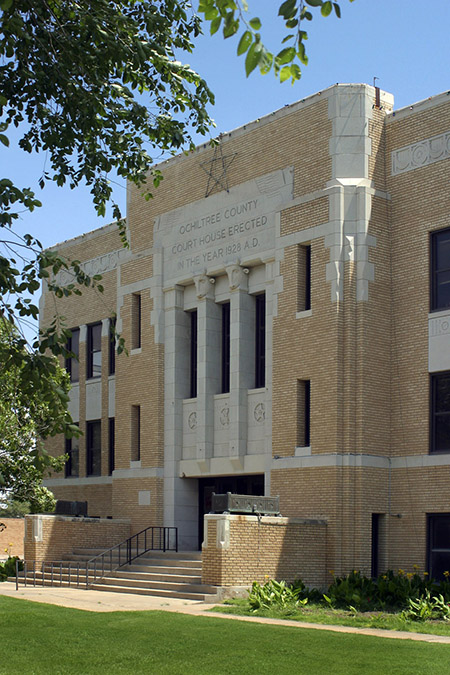 County Seat: Perryton • County Population: 10,223
County Seat: Perryton • County Population: 10,223
County Judge: Earl McKinley
County Commissioners:
- Precinct 1: Duane Pshigoda
- Precinct 2: Doug Barnes
- Precinct 3: Richard Burger
- Precinct 4: Dempsey Malaney
The Ochiltree County Courthouse was erected in 1928 in a Texas Renaissance style as designed by Mann & Co., with an addition completed in 1974.
The county was christened in honor of William Beck Ochiltree, a leader of the Republic of Texas and member of the later secession convention. Perryton, the county capital, refers to a local settler, George M. Perry.
In 1890, the county constructed its inaugural courthouse, a two-story, frame structure enclosed by a woven wire fence, complete with stiles for ingress and egress.
According to June Rayfield Welch, author of “The Texas Courthouse Revisited,” a $5 fine was issued for tying a horse to the fence. The courthouse stood in Ochiltree, the initial county seat.
In 1919, Perryton was elected capital, and the courthouse and jail were moved. However, according to Welch, “The sheriff was reluctant to confine anyone because the jail was a fire hazard. The courthouse was torn down in 1952, to the dismay of many.”
Perryton serves as the gateway to Texas for travel and business. Located just minutes from Oklahoma and less than an hour from Kansas, the area enjoys year-round visitors from many states.
Vast wheat farms have earned the county its well-known title as “Wheatheart of the Nation,” which is celebrated every August in conjunction with Pioneer Day. Events include a parade, barbecue, concerts, car exhibitions, and a 5K run.
Perryton is also the home of John R. Erickson, who has written and published 75 books and more than 600 articles, and is best known as the author of the “Hank the Cowdog” series.
Ochiltree County is proud of its fascinating history, from archaeological discoveries to the historical settling of an entire city at Perryton’s railroad, with details chronicled in the Museum of the Plains.
Museum exhibits include the Spencer Parlor, which depicts what a home may have looked like in 1919 including a “fainting couch” for the ladies when overcome by their tight corsets. The chapel boasts stained glass from the First Baptist Church, arches from the belfry of the First Methodist Church, and the mural of the Jordan River by Garcia Halstead.









